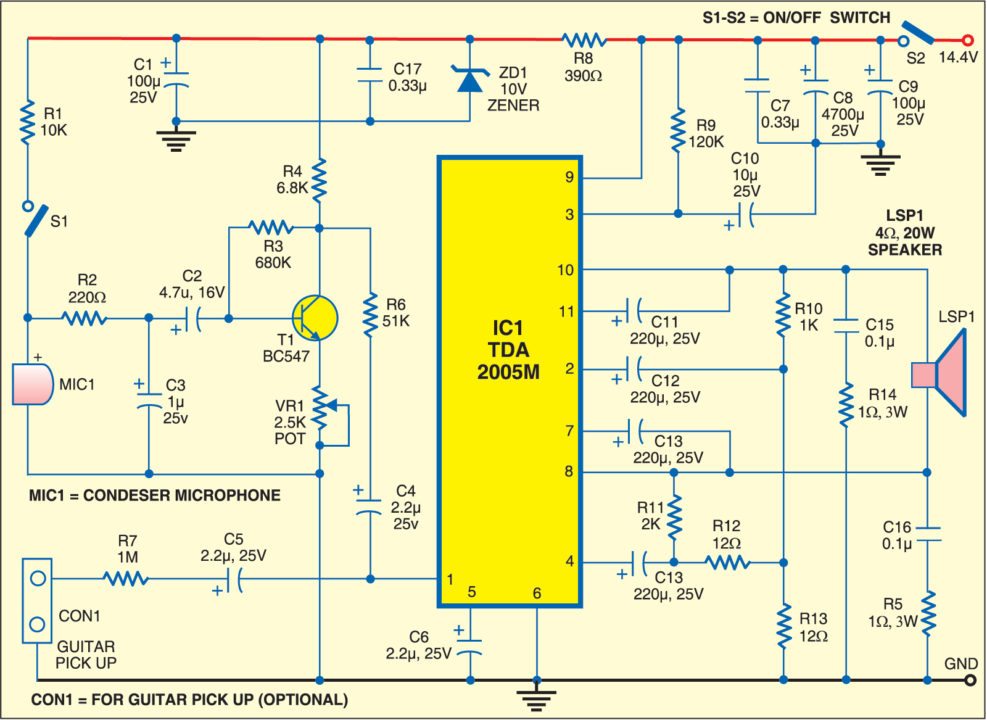
 This simple audio power amplifier works with guitars and microphones, delivering an output power of around 20W over a load of 4 ohms.
This simple audio power amplifier works with guitars and microphones, delivering an output power of around 20W over a load of 4 ohms.
The amplifier circuit is built around IC TDA2005M and a few discrete components. It uses only one potentiometer (VR1), which is quite advantageous as potentiometers take up a lot of space on the board and are difficult to mount and change if damaged. Also, if mounted improperly, potentiometers capture a lot of parasitic signals, especially if there is a strong magnetic field nearby. TDA2005M in bridged configuration is a low-cost IC that provides enough power and quality for portable audio amplifiers. The gain is set to 50 dB and can be reduced if needed. The bandwidth at -3 dB is 40 Hz to more than 20 kHz. The total harmonic distortion (THD) at up to 15W is maximum 1 per cent.
The amplifier has two inputs: one for microphone (MIC1) and the other for guitar pickup (CON1). When switch S1 is closed, a condenser microphone is used as the input. The microphone is dynamic. The distance between the speaker and the microphone determines the volume and the tone. The gain of the stage with T1 can go up to around 120. To lower it, reduce the value of R4 or increase the value of VR1.
Connector CON1 is a high-impedance input for guitar pick-up. Input resistor R7 has a value of around 1 mega-ohm, which can be lowered to 500 kilo-ohms—a value good enough for most passive pickups. The cable between the guitar with passive pickups and CON1 should be 1.5 to 1.8 metres long. CON1 should ground the inputs when not in use. In an environment full of electromagnetic noise, this could be very useful.
Transistor T1 should have a noise rating of 4 dB or lower, a high DC gain of 420 to 800, and a collector current of around 0.5 mA. Suitable transistors are BC109C, BC547, BC549C and BC550C. PN2222A can also be used.
The amplifier works off 12V-18V regulated/ unregulated power supply or a 12V-18V, 3A adaptor, depending on the required output power and selected load resistance. In all cases, the maximum power supply limit of the IC should be adhered to. The parameters of the amplifier are tested at 14.4V. The quiescent current from a 14.4V power supply is typically 75 mA and maximum 150 mA (without input signals, i.e., all inputs shorted to the ground).
Mount IC TDA2005M using a heat-sink with thermal resistance lower than or equal to 4°C/W. Alternatively, use a minimum 2mm thick aluminum metal plate with a surface area of at least 200 cm2. The electrolytic capacitors and the transistor should not be placed too close to the heat-sink.Connect the amplifier output to a 4-ohm, 20W speaker. The circuit handles well load impedance in the range of 4 to 16 ohms but at higher impedances the output power will be lower. So there is no need to use special speakers made for guitar amplifiers, which are expensive. A 20W-50W speaker will suffice for 50 Hz to 9 kHz. Four 8W, 4-ohm speakers connected as a 32W, 4-ohm circuit will also serve the purpose.
The total harmonic distortion (THD) at 20W is around 10 per cent, which is good enough for such a simple and low-cost amplifier. The noise is not noticeable. The amplifier is versatile and can be adapted to a variety of signal sources and applications.






In the diagram it’s said the microphone is Condenser type but the article says it’s Dynamic. Which one to use ?
Can this circuit be used for both types of Microphones ?